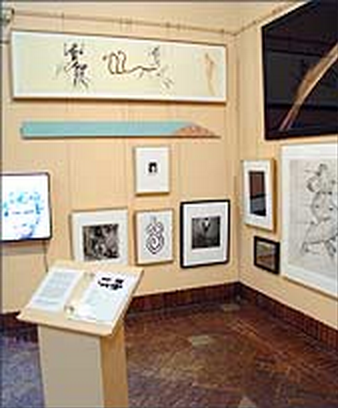QUEERING THE MUSEUM
ALLEN MEMORIAL ART MUSEUM, OBERLIN COLLEGE
05/01/04-06/06/04
Queer. A strange word around which to organize an exhibition. A word that lends itself to many interpretations. Most commonly queer is used as an identifier by and for people who are gay, lesbian, transgendered, bisexual, or who believe they do not fit neatly into any social category considered "normal." Sometimes queer is used as an insult. It can also mean odd, curious, unexpected or strange. In academia, Queer Studies is a category of critical analysis that examines the ways societies construe sexuality in coordination with race, gender, and class. Which definition is being used here?
This exhibition explores the way we "see" contemporary art. The images in the first section of Queering the Museum are photographs, works on paper, paintings and prints from the AMAM's contemporary collection that relate to the human body. The physical arrangement of these artworks recalls the historical mode of salon-style hanging. The presentation of information on the lecterns recalls display practices often associated with natural history museums--a style of labeling that places a critical distance between viewers and objects.
Labels can also affect the way we perceive art. Felix Gonzalez-Torres, a contemporary American artist once said, "As you know, labels are very useful when you want to be in control." Although he was referring to social labels, Gonzalez-Torres' statement can be applied to the labels found in museums. The primary author, the curator, works with other key players within the museum institution--the director, the education department--to develop the tone and content of each label. Essentially, the curatorial/institutional voice is the one presented. This idea inspired the second section of Queering the Museum. Scattered throughout the museums' galleries are more than a dozen labels that represent other voices. These labels, distinguishable by the "QTM" icon, explore the perceptions of children, the methods of educators, and the responses of Oberlin students to particular works of art. Many of these labels do not present facts, but convey points of view rarely presented within the walls of a museum.
Tanzio da Varallo, St. John the Baptist, ca. 1618
Oil on Canvas
R. T. Miller Jr. and Mrs. F. F. Prentiss funds, 1987.34
The Passion of John the Baptist
I've lost my innocence
and my clothes: a bed sheet
will have to do.
I'm an unperfected shepherd;
I don't lead sheep,
I pet them.
I've held this cross
for too long, it is time
that I was held.
It only took one restless night
to disturb my father
from his dreams.
But I'd never felt
anything like this
before, nothing had ever felt me.
I am told the Lord is my shepherd,
I shall not want.
But O my God, how I want...
-Drew Krewer
Sue Angell, "Senior Curates Exhibition at the Allen Memorial Art Museum" Oberlin Online









